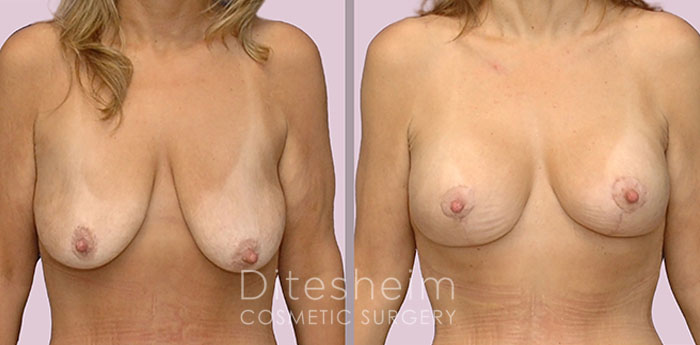- Plastic Surgery
- Liposuction
- MedSpa
- Patients Gallery
- Our Practice
- Resources
- Contact


This Technique Delivers Smaller, Lifted Breasts
Most women with uncomfortably large breasts think about having a breast reduction for a long time before “pulling the trigger.” Many women are held back by fears of surgery, anesthesia, being too small, being left with bad scars, feeling disfigured, spending money, or making a drastic change. These are very real fears. If you are considering breast reduction surgery and one or more of these fears are holding you back, you should know about a new technique that minimizes many of these fears and can lift and reshape your breasts while making them more comfortable.
Women with very large or hanging breasts just want the pain and discomfort in the neck, back or shoulders to go away. Simply, all breast reduction procedures deliver smaller breasts. Once the pain is gone, how pretty are the breasts? Are they perky? Are they proportional for your body? How are the scars? Relief from neck and back pain should not have to come with a less than pleasing result.
Lollipop Breast Reduction
This new technique, often called a “lollipop breast reduction” because the scar resembles a lollipop shape, reshapes while it reduces the breast. The upper part of the breast that gives you cleavage and perkiness is preserved while the hanging or saggy part is removed. Think about it – when you look down, you likely feel the breast is flat on top and too wide. When the breast is reduced with this technique, the upper breast become fuller and the base of the breast becomes narrower – reshaping to create a perkier and prettier breast.
Quicker Recovery
With the lollipop breast reduction technique, you can expect relief of discomfort and a shapelier breast. Even better, there is considerably less recovery time needed. There is usually no drain, which means less post-op pain. There is less swelling and bruising. Most patients can return to work or regular daily activities within 3-7days.
Less Scarring
The lollipop breast reduction procedure leaves less scarring and a great long-term shape. There is no side-to-side scar in the breast crease so there is no scar under the arm or peeking scar in the cleavage. With this technique, there is a circular scar around the areola and a fine line from the areola to the breast crease. By removing only what is truly extra skin, the scars can heal as fine lines.
Conventional Breast Reduction
Most surgeons still use what is called the “anchor scar breast reduction.” This is a seamstress-like technique that places a pattern on the breast to define how much skin and volume to remove. With this technique, the breasts are reduced and discomfort is relieved. The breasts are smaller but usually flatter and there is a more visible scar. Over time, the shape of the breasts can become droopier or “bottom out.” This creates hollowness on top and more fullness on the bottom. So why do most plastic surgeons use this approach? This is the technique that was taught in training and it is what most surgeons are comfortable with. This procedure also follows a pattern; it is a straightforward cut and reduce technique and is very left-brain, very surgical. This technique was never designed to be a reshaping approach. In contrast, the lollipop breast reduction considers the breast three dimensionally and is primarily a reshaping approach which is more right brain and artistic.
If you are suffering with back, neck, or shoulder pain, you need smaller breasts. But, as a woman, you want comfort, minimal scar, quick recovery and beautiful breasts. Why not reshape while you downsize? With the lollipop breast reduction technique, you can have both.
Dr. Jeffrey Ditesheim is more than a credentialed plastic surgeon. He is a sensitive and experienced professional whose focus is always to help his patient feel more beautiful and confident. Learn more about Dr. Ditesheim




 (704) 542-8686
(704) 542-8686